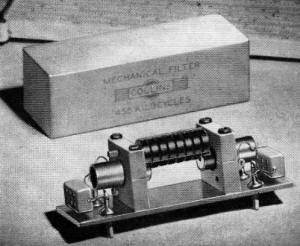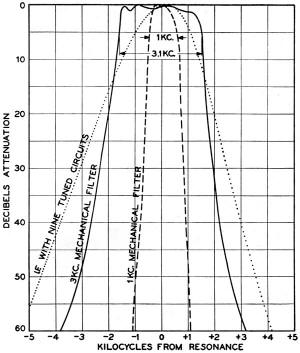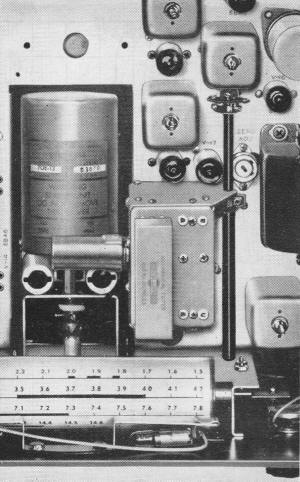Mechanical Bandpass Filters for I.F. Ranges |
|
Magnetostriction is a term not seen very often these days. It describes the physical shape change that takes place in certain ferrous materials when subject to a magnetic field, and is responsible for most of the familiar "hum" that comes from transformers (the other part comes from attracting and opposing fields rattling the windings). The effect is used in mechanical filters as transducers between the electronic circuit and the mechanically resonant disks that define filter bandpass characteristics. Elemental cobalt exhibits the highest room temperature magnetostriction (units are "microstrains"). Nickel, with about half the value as cobalt, is cheaper and more abundant and is therefor more commonly used in modern magnetorestrictive transducers. Way back in the 1980s while working at the Oceanic Division of Westinghouse Electric, in Annapolis, MD, I built sonar transducer arrays that used a linear arrangement of rectangular ceramic elements having a layer of nickel deposited on opposing surfaces (which, conveniently, made for good soldering of interconnect wires). Those ceramic elements were physically sized to transmit and receive specific frequencies used by the sonar. Mechanical Bandpass Filters for I.F. Ranges The mechanical filter is shown here removed from its 2 13/16 X 1 X 15/16·inch case. The filter proper consists of the small disks in the center - each one is carefully machined to the correct dimensions to give the proper mechanical resonance. An Approach to the Ideal Selectivity Curve By Ben Roberts,* W0IEU For a good solid QSO in a crowded amateur band, we like to hear just one signal and nothing but that signal. The receiver that will come closest to meeting this requirement must have a selectivity curve with a flat top, straight vertical sides, and a bandwidth only wide enough to pass the desired signal. This is the "ideal" selectivity curve. Receiver selectivity is usually increased by adding tuned i.f. stages. However, when this method is used to increase selectivity, even to the point where so much sideband power is lost that 'phone signals become unintelligible, the skirts of the selectivity curve may still be broad enough to pass interference from strong signals a few kilocycles away. Crystal-lattice filters1 offer one approach to the ideal selectivity characteristic, but they are usually expensive and their commercial use has been confined to telephone-company applications. The Mechanical Filter An entirely new approach to high selectivity is available through the use of the "mechanical filter," a resonant mechanical device. Shown in the photograph, it consists of three sections: an input transducer, a mechanically-resonant filter section, and an output transducer. The input and output transducers are identical and use magneto-striction to convert the electrical signal to mechanical energy and vice versa. Three small metal rods are used to connect together the resonant disks of the filter section. The second disk from each end connects to a transducer by means of a small metal rod, and the two end disks are secured to the transducer housings to serve as supports for the filter section. If you have been waiting for "something new" in the selectivity department, here it is. By cascading accurately-machined bits of metal, bandpass filters can be built in the i.f. range that approach in performance the straight-sided "ideal," and this article describes their operation and their advantages. Unless you are a genius who has a more practical solution to the problem of crowded bands than the use of higher selectivity, we're sure you will want to know something about this latest development. Fig. 1 - Selectivity at 455 kc. of two mechanical filters of different bandwidths, shown for comparison with the selectivity obtainable with nine tuned circuits at the same frequency. The narrower "skirts" and the flat "top" of the mechanical filters account for their superior performance in crowded amateur bands. Magnetostriction, which makes possible the electrical-to-mechanical and mechanical-to-electrical transformation of energy in the transducers, is a fairly well-known but rarely used phenomenon. When a highly magnetic substance such as nickel is subjected to magnetic flux, the shape and volume of the magnetic substance change. The metal will elongate, twist, or bend. The magnetostrictive transducer used at each end of the mechanical filter consists of a small coil of wire surrounding a nickel core. Application of a 455-kc. signal (or whatever other frequency the filter is designed for) to the input coil causes a magnetostrictive action resulting in a mechanical vibration of the nickel core. This 455-kc. mechanical vibration is transmitted through the interconnecting metal rods to the mechanically-resonant disks of the filter proper. Each disk is mechanically driven by the preceding disk, so that all of the disks vibrate at 455 kc. The last resonant disk drives the core of the output transducer. Here the vibrations of the nickel core are changed by magnetostriction into a varying magnetic field. The output coil intercepts this field and supplies a 455-kc. output voltage. In order to avoid a frequency-doubling action that would generate a mechanical cycle for each electrical half-cycle, a small magnet in the mounting above each transducer applies a magnetic bias to the nickel transducer core. The electrical pulses then add to or subtract from the magnetism that already exists, causing the filter elements to reproduce the input cycle. There is no movement in the mechanical filter except for the imperceptible vibration of the internal filter elements. The mechanically-resonant disks of the filter proper have extremely low losses at their resonant frequencies. Each disk has a Q greater than 2000. Q These high-Q components exhibit characteristics that make possible application of the theory of lossless elements to filter design. A mechanical filter can be constructed for either narrow or broad bandpass without sacrificing its nearly rectangular selectivity curve. The relatively low Q of electrical elements does not permit the design of equivalent electrical filters. Typical characteristics obtainable with mechanical filters are shown in Fig. 1, with the selectivity curve of an i.f, amplifier using nine tuned circuits (electrical elements) shown for comparison. The transmission loss of 23 db. or so through the 3-kc. mechanical filter is made up easily by subsequent amplification by vacuum tubes. Once the mechanical filter has been constructed, it is enclosed in a hermetically-sealed case and requires no further adjustment. Connections to the input and output transducer coils are brought out of the unit on feed-through insulators whose edges are sealed to the case. Using the Filter A receiver using the 3-kc. mechanical filter in its i.f. amplifier handles differently than one with a conventional selectivity characteristic. As the receiver is tuned across the band, signals appear and disappear with more than usual suddenness. The straight-sided selectivity curve makes the band appear less crowded - such a curve is easier to interpose between two signals without responding to either of them. Using a steep-sided 3-kc. bandwidth for 'phone reception is by no means standard procedure, and it requires a bit of explanation. With a good conventional i.f. curve, like the one obtained from nine turned circuits and shown in Fig. 1, the carrier frequency must be tuned very close to the center of the selectivity curve. This is because the carrier level decreases as the receiver is tuned off. As the signal is moved off the center of the selectivity curve, the carrier level decreases but one of the sidebands does not. This results in too much sideband for the available carrier amplitude and causes the distortion (overmodulation at the detector) that always results when a receiver with a rounded selectivity curve is not tuned "on the nose." The only way to avoid this distortion is to tune the receiver to the carrier rather than to a sideband. This is the conventional way to tune a receiver; however, when we do this, we are splitting our available bandwidth between two sidebands, although we need to receive only one. Therefore, if a receiver with a conventional i.f. curve has a 3-kc. bandwidth and is tuned to the carrier, as it must be for distortionless reception, it will respond to audio frequencies up to about 1500 cycles - not to 3000 cycles as is sometimes assumed. To accept side frequencies up to 3000 cycles, the carrier must be set off to one side, and distortion will result, except at very low percentages of modulation. But the curve of the mechanical filter has a flat top, and setting the carrier off to one side does not substantially reduce its amplitude with respect to the sideband. By keeping the carrier inside of the flat-topped selectivity curve, we can tune to either sideband without introducing the "overmodulation" type of distortion. Since it is no longer necessary to split the available bandwidth between two sidebands, we can pass a given range of audio frequencies with a passband only half as wide as would be required with a conventional i.f. selectivity curve. Since only one sideband is needed for reception of a signal, setting the carrier at one edge of the passband will still permit us to hear all of the audio frequencies up to 3000 cycles, when the 3-kc. mechanical filter is used. A top view of part of the Collins 75A-3 receiver, showing the mechanical filter mounted to the right of the tuning unit. Sockets are provided for an additional filter section if desired, The shaft along the right-hand side of the filter platform is a double shaft - the outer shaft permits switching between the two filter units, and the inner shaft is the b.f.o. pitch control. The 3-kc. filter is excellent for use in reception of s.s.b. signals, when used with a receiver of good oscillator stability. It has the correct bandwidth for s.s.b. reception, although the 1-kc. filter can be used when conditions require extreme selectivity. Under such conditions, the reinserted carrier (b.f.o.) is set about 300 cycles outside the i.f. passband, allowing an audio range of 300 to 1300 cycles to be received. The good skirt selectivity of the mechanical filter allows it to reject the carrier and one sideband of an ordinary a.m. signal, thus converting it to a s.s.b. signal in the receiver past the filter. The b.f.o. is then set just outside the filter passband, to coincide with the frequency of the eliminated carrier, for proper detection. This type of s.s.b.-plus-exalted-carrier reception minimizes the effects of selective fading and of certain types of noise. Either the 3- or the 1-kc. filter can be used in this application. The Filter Applied to the Collins 75A-3 Receiver The amount of selectivity that is desirable in a communications receiver is a good subject for debate. Most of us like a very selective receiver, but we also want faithful reproduction when 'phone signals are in the clear. Development of the mechanical filter has solved this problem, since to change the selectivity of a receiver using the filter it is only necessary to cut in a filter of different bandwidth. The new Collins 75A-3 receiver is supplied with a 3-kc. mechanical filter and has plug-in provisions for the optional installation of a 1-kc. filter. The 3-kc. filter is ideally suited for all types of 'phone reception including s.s.b., and for exalted-carrier reception of regular a.m. signals. Even the 1-kc. c.w. filter can be used for 'phone reception, as described above. The crystal filter is retained for phasing out heterodynes. The mechanical filter is not just an accessory, but is an entirely new development in communications. It shows promise for use in many applications, including the simplification of single-sideband transmitter circuits. Presently, development work is proceeding toward the production of mechanical filters with higher and lower operating frequencies and bandwidths as required for special applications. * c/o Collins Radio Co., Cedar Rapids, Iowa. 1) Weaver and Brown, "Crystal Lattice Filters for Transmitting and Receiving," Part I, June, 1951, QST.
Posted November 3, 2021 |
|



